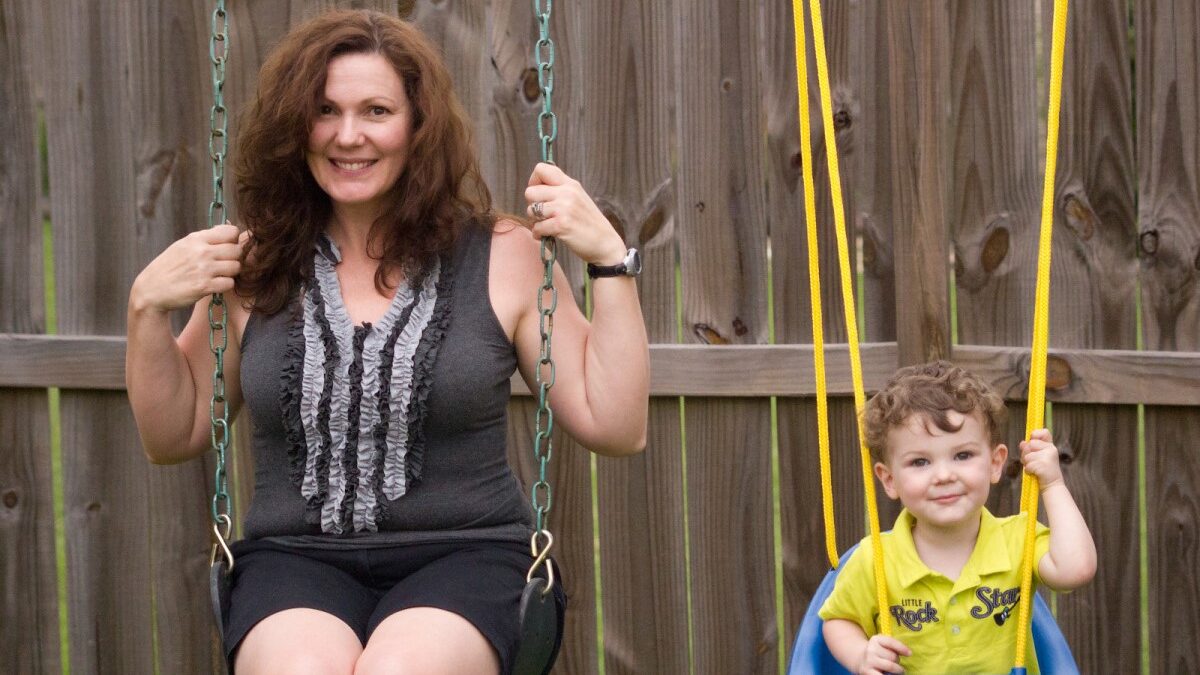
At three children, contemporary parenting practices have a fateful battle with reality. Necessity, that mother of invention, intervenes at three kids. Moms—and dads, of course, although I will mostly discuss moms because, fair or not, women’s notions of motherhood largely dictate parenting debates—must toss out many modern notions of perfect parenting at the jump from two to three. When that happens, we often find that the old ways of raising kids are not only easier, but better for all involved.
Here are four truths about children mothers and fathers typically learn by the third child (plus a bonus).
1. Counterintuitive But True: Earlier Is Easier.
Survey says women view motherhood as a late-30’s thing. Surveys also say that women in the United States and Europe want more children than they actually have. To have more children, women have to start getting pregnant earlier, which is a highly contentious point because society trains young women to put their career first.
We have reversed the life-streaming that Betty Friedan complained about in “The Feminine Mystique.” She described society’s insistence that women fulfill their roles as wives and mothers before anything else as one of those untenable “one thing at a time compromises” because if single-minded housewifery had to come first and only, then careers would rarely happen. Now, the one thing at a time career-first advice sometimes means that motherhood might not happen.
Earlier doesn’t just make motherhood easier, it often makes it possible. But earlier also makes motherhood easier and not just for the commonly cited and too-obvious-to-ignore fact that younger mothers have more energy to endure sleep deprivation and busy toddlers. Earlier also means that women can avoid the long-term hormone dosing required to achieve the career-first life plan.
Women spend about a quarter-century on low-dose synthetic hormones to avoid pregnancy and then many spend a few years on massive-dose synthetic hormones to achieve pregnancy. While in everything else we admonish each other to trust our bodies’ rhythms to get sufficient sleep, proper food, and avoid stress, we override our bodies’ natural reproductive rhythms and expose ourselves to significant health risks with hardly a thought. Frankly, I’ve seen enough women go through the physical and emotional roller-coaster of in-vitro fertilization that I have nothing left but distain for the conventional wisdom about systematic delayed childbearing. Friedan was right. Women don’t have the option of linear, one thing at a time life plans.
Furthermore, a huge but seldom-discussed disadvantage of the career-first plan: delayed childbearing comes at a very inconvenient point in a career arc. Delayed childbearing puts professionally ambitious women in maternity binds about 15 years into their career, a point of higher-level advancement. It is not mere chance that saw Margaret Thatcher break the ultimate glass ceiling in the United Kingdom. She had her children earlier and therefore had an unbroken path to Number 10 from the time they started grade school and she won her first seat.
Worse still, fertility pressure leads to “baby bunching.” Career-first-focused women often don’t anticipate how much they will enjoy being mothers. When this surprise hits they get pregnant in quick succession to have more than one child. I’ve not seen any study on child spacing and career, but I have a theory that baby bunching does more career damage than three-year gaps. Anecdotal recommendations that careers can only handle one child suggest that I might be on to something. Two children at this stage with full American maternity leave is career sabotage. Two children on longer European maternity leave schemes—that alone explains their hardly cracked glass ceilings. Babies spaced 18 months apart will see a mother in the office for three of 24 months at a career ascension point.
Baby bunching is also extremely work-intensive. An 18-month-old and an infant need constant, vigilant supervision, while a six-year-old can help with small tasks and sibling entertainment. Even 10-minute diversions bolster early childhood parental sanity and multitasking ability. And sibling participation does wonders for children’s responsibility growth and sibling relationships.
Beyond those details, distill the arguments for earlier childbearing, and we are left with the fact that it forces planning. Delayed childbearing is often procrastination. Waiting for the right guy, the right time, the right community—it’s passive. Advance planning makes life easier—usually anyway. (For those who refuse to adapt when things don’t conform to plan, that is a systemic problem that makes everything difficult, not just parenthood.)
2. Budgets Become Family Budgets with the Second Child.
Three children isn’t cheaper than two children, but the budget impact isn’t all addition. In an odd way, the third child can prompt a reduction in some expenses and streamline family life.
Having a family is expensive, and the biggest expense jumps occur at zero to one and one to two. By two children, families already have the baby gear and supply of hand-me-downs. They also likely have the family car and home. Most sedans cannot accommodate an infant seat and rear-facing toddler seat, and most apartments or starter houses fail an assortment of family requirements that are apparent by two children.
Similar holds for childcare. Daycares and preschools offer third-child discounts, which mitigate the budget burden of a third child only a little bit. But for the middle class, daycare expenses often absorb one parent’s salary by two children. That budget reality coupled with the juggling difficulties of two working parents with two children often leads one parent to work from or stay at home. One parent at home lessens the juggle with little bottom-line impact on the family budget. (For parents who can afford nannies, nanny salaries vary more by experience level than the jump from two to three children.)
Cost of primary and secondary education heavily impacts family finances for families who use private schooling. But again, the private tuition vs. good-public-school-with-high-property-taxes math typically breaks even a little under two kids. (If anyone knows of a formal study on this, please comment with a link. I know many families did the math—my husband did a detailed Excel sheet with a present value end calculation for London and Houston—but I’ve not found formal data on this point.) Depending on the city, the school, and family income, the difference might be small enough that some families could still reach private tuition until adding a third child, but moving to a good public school is usually the budget call at two children.
Beyond the private school question, much of the financial burden of parenthood comes from modern parenting norms, such as the hundreds or even thousands of dollars spent each month on enriching activities. A third child prompts parents to reconsider all the scheduled enrichment if only because the activity shuttling schedule that was just manageable at two children becomes an impossibility at three children. This doesn’t happen all at once, some parents are more determined to conform to the modern activity norms, but eventually the budget gets a trim and family life gets a little less harried.
3. We Can’t Helicopter Parent Three Children.
Helicopter parenting is almost intuitive at one child. Parents not only can do everything for onlys, but also, as anyone who has watched a two-year-old dress herself knows, it seems easier, or at least faster, for the parents to do everything. Maintaining the same level of control for two children is utterly exhausting. Micromanaging the individual children consumes enough time. Negotiating their interaction consumes the rest.
But we can’t helicopter parent three children. We can hire nannies to helicopter the children, but that is an advantage only available to the very well-off. We can rely on grandparents to hover over the children, but that requires 1) grandparents willing to hover and 2) parents to start relying on a village. (See below.)
Throw in the disadvantage to children, the isolation of motherhood, the common marital strain in child-centered marriages, as well as the nervous breakdown for any who actually attempt hovering over three, and in short order the elder generation’s backed-off parenting style starts making sense.
Parents of three revert to the backed-off style in resignation, at first comforting themselves with notions of “good-enough parenting.” (For the readers who might notice that there is a catchy name for every aspect of parenting, yes, there is. It’s part of the quest for a unified theory of parenting. We want to identify with a style, a group. Why this is so is an interesting discussion for another day.)
Parents of three might not quit hovering cold turkey, but do relax and pull back. And so, parenting eventually gets a little easier and the children gain more independence. This inspires parents to pull back a bit more. It is a virtuous cycle.
4. The Reality Check on Helicopter Parenting Opens the Possibility of Returning to the Village.
Mothers often lament, “What ever happened to the village?” Decades of social policy weakened marriage and familial ties and razed the villages. Once the villages were gone, we lost our trust in community. These days it doesn’t matter if one thinks of the village in the Clintonian sense of a government-supplied village or in the traditional, and better, sense of a neighborhood village. We avoid the village if able. (And one of the undercurrents of the calls for universal daycare is privileged women who neither need nor would they use daycare, calling for it on behalf of poorer women. I see it as subliminal guilt for killing the village and raising the intensity of childcare to a level many women will never be able to match.)
Motherhood is all or nothing. A woman figures either she gave up a lucrative career to stay at home with her children, therefore, any use of a village cheapens her sacrifice or, if a mother substitute will ever suffice, then why not get full time childcare and get back to work? It’s as if women lost the ability to distinguish between “mother care is best” and “only mother care will do.”
This all or nothing reasoning often collapses with a third child. We lose the “luxury” of rebuffing help. And when we let others help, we find things get easier. Kids start responding to other authority. Husbands pitch in more. The precious and irreplaceable relationships with grandparents, elders, and fathers have an opportunity to flourish. And mothers manage some time for other pursuits.
Bonus: At Three Children We Tend to Say Goodbye to the Mommy Wars.
Women are sick of the “to work, or not to work” Mommy Wars. Mommy bloggers regularly plea for a truce. But as nice as it sounds, the often-offered solution of mutual support for each other’s choices will not end the Mommy Wars. We fight because we aren’t sure of those choices.
A long-story summary: Second Wave feminists replaced one mystique, the happy housewife, with others, the career mystique or sex goddess mystique. Controlled by those mystiques until baby hunger strikes, many women take pride in having little experience with children until their own arrives. The resulting insecurity drives the Mommy Wars. We want, we need, endorsement. We have no other way of determining if we are doing it right. And, often surprised by the intensity of motherhood, we really want to do it right.
But lurk on the cyber-battlefields, and notice that the women above the fray have three or more children, older children, and/or had childcare experience growing up. They are confident of their parenting decisions—not the blustering, trying-to-convince-themselves confidence, but actual confidence that can stand on its own.
It doesn’t happen at the third birth. And varied details such as child spacing or disposable income affect resistance, but three children is the point at which so many bad but popular ideas for women and children finally fall.









